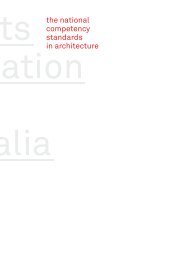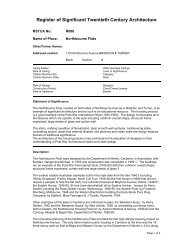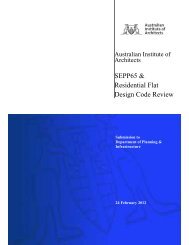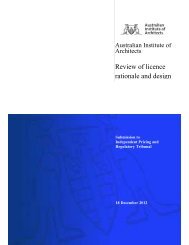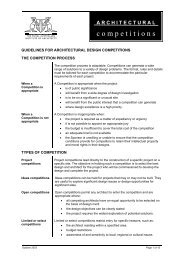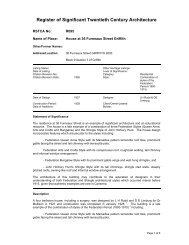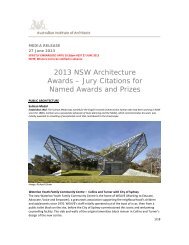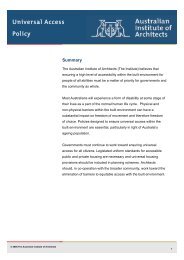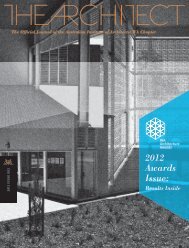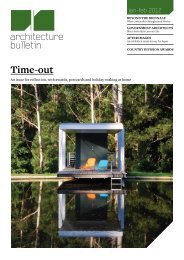Draft Competitive Design Policy - Australian Institute of Architects
Draft Competitive Design Policy - Australian Institute of Architects
Draft Competitive Design Policy - Australian Institute of Architects
Create successful ePaper yourself
Turn your PDF publications into a flip-book with our unique Google optimized e-Paper software.
<strong>Australian</strong> <strong>Institute</strong> <strong>of</strong><strong>Architects</strong><strong>Draft</strong> <strong>Competitive</strong><strong>Design</strong> <strong>Policy</strong>Submission toCity <strong>of</strong> Sydney21 April 2011
SUBMISSION BY<strong>Australian</strong> <strong>Institute</strong> <strong>of</strong> <strong>Architects</strong> – NSW ChapterABN 72 000 023 012Tusculum, 3 Manning StreetPOTTS POINT NSW 2011Telephone: 02 9246 4055Facsimile: 02 9246 4030email: nsw@raia.com.auPURPOSEThis submission is made by the NSW Chapter <strong>of</strong> the <strong>Australian</strong> <strong>Institute</strong> <strong>of</strong><strong>Architects</strong> (the <strong>Institute</strong>) to the City <strong>of</strong> Sydney in response to the draft<strong>Competitive</strong> <strong>Design</strong> <strong>Policy</strong>.At the time <strong>of</strong> the submission the <strong>of</strong>fice bearers <strong>of</strong> the NSW Chapter are:Matthew Pullinger (President), Brian Zulaikha (Immediate Past-President),Joe Agius, Kim Crestani, Adam Haddow, David Holm, Esteban Insausti,Chris Jenkins, Alex Kibble, Stuart Landigan, Gerard Reinmuth, PeterSarlos, Howard Smith, David Springett.The Office Manager <strong>of</strong> the NSW Chapter is Roslyn Irons. This paper wasprepared by Murray Brown, <strong>Policy</strong> & Pr<strong>of</strong>essional Development Manager,for the NSW Chapter’s Built Environment Committee, chaired by StephenBuzacott.INFORMATIONWho is making this submission? The <strong>Australian</strong> <strong>Institute</strong> <strong>of</strong> <strong>Architects</strong> (the <strong>Institute</strong>) is an independentvoluntary subscription-based member organization with approximately10,153 members who are bound by a Code <strong>of</strong> Conduct and DisciplinaryProcedures.The <strong>Institute</strong>, incorporated in 1929, is one <strong>of</strong> the 96 member associations<strong>of</strong> the International Union <strong>of</strong> <strong>Architects</strong> (UIA) and is represented on theInternational Practice Commission.The <strong>Institute</strong>’s New South Wales Chapter has 2,959 members, <strong>of</strong> which1,700 are registrable architect members – representing 56% <strong>of</strong> allregistered architects in NSW.Where does the <strong>Institute</strong> rank as a pr<strong>of</strong>essional association? At 10,153 members, the RAIA represents the largest group <strong>of</strong> nonengineerdesign pr<strong>of</strong>essionals in Australia.<strong>Australian</strong> <strong>Institute</strong> <strong>of</strong> <strong>Architects</strong> (NSW)City <strong>of</strong> Sydney draft <strong>Competitive</strong> <strong>Design</strong> <strong>Policy</strong>21 April 2011i
Other related organisations by membership size include: The <strong>Design</strong><strong>Institute</strong> <strong>of</strong> Australia (DIA) - 1,500 members; the Building <strong>Design</strong>ersAssociation <strong>of</strong> Australia (BDAA) - 2,200 members; the <strong>Australian</strong> <strong>Institute</strong><strong>of</strong> Landscape <strong>Architects</strong> (AILA) 1,000 members; and the <strong>Australian</strong>Academy <strong>of</strong> <strong>Design</strong> (AAD) - 150 members.<strong>Australian</strong> <strong>Institute</strong> <strong>of</strong> <strong>Architects</strong> (NSW)City <strong>of</strong> Sydney draft <strong>Competitive</strong> <strong>Design</strong> <strong>Policy</strong>21 April 2011ii
<strong>Australian</strong> <strong>Institute</strong><strong>of</strong> <strong>Architects</strong><strong>Draft</strong> <strong>Competitive</strong><strong>Design</strong> <strong>Policy</strong>Submission toStanding Committee on StateDevelopmentNSW Parliament
CONTENTSPageFEES 1POLICY TRIGGER 1COMPETITION ALTERNATIVES 2JURY SELECTION AND CONDUCT 2MAXIMUM DESIGN REQUIREMENTS 3RECOGNITION OF PRIOR INVOLVEMENT / SITE MASTERPLANNING 3
The <strong>Institute</strong> acknowledges the City’s competitive design policy as a positivecontribution to design excellence and as a means <strong>of</strong> encouraging emergingarchitectural practices in NSW.Before an extension <strong>of</strong> the policy is considered, however, the <strong>Institute</strong>recommends that the Council undertakes an audit to determine theeffectiveness <strong>of</strong> the present policy and also whether it achieves equitableoutcomes for the participants.Specifically the <strong>Institute</strong> would like the Council to provide metrics on thefollowing:• number <strong>of</strong> projects affected each year, both past and projected;• actual cost to the architecture pr<strong>of</strong>ession <strong>of</strong> the policy, both past andprojected;• actual financial incentives given to developers for participation; and• financial impacts to the pr<strong>of</strong>ession in the expansion <strong>of</strong> the policy.FeesBased on the advice <strong>of</strong> many <strong>of</strong> its members, the <strong>Institute</strong> is extremelyconcerned about the very low fees <strong>of</strong>fered and paid to architects forparticipation in competitions under the policy.The Council gives very significant financial incentives to developers toencourage them to administer competitions under the policy, yet at the sametime it allows architects’ fees to be determined by ‘market forces’. This meansthat our members are, in effect, subsidizing the operation <strong>of</strong> the policy.In the <strong>Institute</strong>’s view the policy should require developers to direct adesignated percentage <strong>of</strong> the financial incentives they receive to thecompetition process so that competitors are properly compensated for theirparticipation. The <strong>Institute</strong>’s Guidelines for Architectural <strong>Design</strong> Competitionsincludes a scale <strong>of</strong> fees that, adjusted for CPI increases since the publicationdate <strong>of</strong> 2003, could provide the template for a more equitable scale <strong>of</strong> fees<strong>of</strong>fered through the City’s competition process.<strong>Policy</strong> triggerThe <strong>Institute</strong> notes that the design excellence clauses <strong>of</strong> the draft LEPpropose triggers for this policy to come into effect <strong>of</strong>:i. a building height <strong>of</strong> more than 25 metres (55 metres in central Sydney);orii. development cost <strong>of</strong> more than $50M.While we consider that height is a more reliable and useful trigger thandevelopment cost we note that a trigger <strong>of</strong> 25 metres outside the CBD wouldcapture most buildings above seven stories in height. We consider this is too<strong>Australian</strong> <strong>Institute</strong> <strong>of</strong> <strong>Architects</strong> (NSW)City <strong>of</strong> Sydney draft <strong>Competitive</strong> <strong>Design</strong> <strong>Policy</strong>21 April 20111
low and in any case does not provide a mechanism for the most effective use<strong>of</strong> the competition process; on the contrary, it could encourage the excessiveuse <strong>of</strong> the process, which is likely to debase it.In the <strong>Institute</strong>’s view the real trigger for the policy should be the significance<strong>of</strong> the site, based on an analysis <strong>of</strong> key factors such as view corridors, cornerposition, etc. While this analysis may require updating each decade as the citydevelops, it could be a more useful means <strong>of</strong> identifying sites where thecompetition process makes a positive contribution to the development <strong>of</strong> amore cohesive and stimulating urban environment.Competition alternativesThe <strong>Institute</strong> notes the three types <strong>of</strong> competition presented as alternatives inthe policy. While the distinction between ‘open’ and ‘invited’ architecturaldesign competitions is expressed clearly the distinction between the ‘invited’architectural design competition and the ‘invited’ competitive designalternatives process is not as clear.The <strong>Institute</strong> is concerned that, because its outcome will not necessarily leadto a winning design that eventually takes the form <strong>of</strong> a developmentapplication, the design alternatives process is open to abuse in two respects:1. developers may engage in a design ‘fishing expedition’ with noguarantee <strong>of</strong> the selection <strong>of</strong> a winning design; and2. architectural practices may be required to provide several iterations <strong>of</strong>a design alternative without any variation to the fee.The <strong>Institute</strong> recommends amendments to the policy to clearly indicate thesituations in which it is appropriate to select the ‘invited’ competitive designalternatives process in preference to the ‘invited’ architectural designcompetition process.As a positive means <strong>of</strong> encouraging the involvement <strong>of</strong> emerging practices inthe competition process, the <strong>Institute</strong> also recommends that at least one <strong>of</strong> thefive or more competitors invited to participate in an ‘invited’ architecturaldesign competition should be able to be described as an ‘emerging practice’.Jury selection and conductThe <strong>Institute</strong> notes that competition juries are to consist <strong>of</strong> ‘a majority <strong>of</strong>registered architects with urban design expertise’ and supports thisrequirement. The policy is silent, however, on the process for selecting jurors;it also does not specify a process for selecting the architectural practices thatare to participate in a competition process. It is critical that selection anddecisions are transparent, on the public record, and that all probity issuesregarding them are addressed in the policy.<strong>Australian</strong> <strong>Institute</strong> <strong>of</strong> <strong>Architects</strong> (NSW)City <strong>of</strong> Sydney draft <strong>Competitive</strong> <strong>Design</strong> <strong>Policy</strong>21 April 20112
One solution may be to appoint a small committee, separate from thecompetition jury, which has oversight <strong>of</strong> the competition process in regard toprobity, fees, communication and other matters <strong>of</strong> a non-design nature. Itcould include representatives from the Council and the <strong>Institute</strong> and a thirdnon-affiliated member with expertise in audit processes. The committee wouldperform a role similar to that <strong>of</strong> the ‘advisor’ described in the <strong>Institute</strong>’sGuidelines for Architectural <strong>Design</strong> Competitions.It is critical that juries are properly briefed on their role - inclusive <strong>of</strong> thelimitations and bounds <strong>of</strong> their recommendations. The <strong>Institute</strong> is aware <strong>of</strong>instances where juries have assessed the architectural practices participatingin a competitive process rather than the actual architectural proposals theysubmit.We also note that in some jurisdictions in which the design competition modelis used there have been instances in which individual jurors make contact withcompetition participants during the period leading up to the final judgingprocess. The <strong>Institute</strong> considers it would be prudent to include in the policy orin written instructions to jury members the requirement that only the full juryshould be engaged in any discussions with participants prior to the formaljudging process.Maximum design requirementsWe are advised that in some instances architectural practices have preparedmodels, computer fly-throughs and other representations <strong>of</strong> the proposeddesign that exceed the maximum design requirements <strong>of</strong> the brief. The<strong>Institute</strong> will endeavour to advise its members not to engage in this practice;the policy should stipulate that juries will refuse to see any material that is notspecifically requested in the brief. Participating architects entering thecompetition should also be advised <strong>of</strong> this requirement, which accords withthe <strong>Institute</strong>’s Guidelines for Architectural <strong>Design</strong> Competitions.Recognition <strong>of</strong> prior involvement / site masterplanningDevelopers <strong>of</strong>ten ask architects to conduct feasibility studies for sites, testingcontrols etc as part <strong>of</strong> their due diligence prior to acquisition. The policyshould acknowledge this practice so that architects providing this assistanceare not excluded from the competition process. Any prior work <strong>of</strong> this kindshould be included in the brief, so that architects in the competition haveaccess to the same information as an architect who has previously assistedthe client.The policy also does not take into account the increasing practice <strong>of</strong>architectural practices working closely with developers in exploring a range <strong>of</strong>design concepts in the masterplanning for key sites well before thecommencement <strong>of</strong> the preparation <strong>of</strong> development applications.Without in any way wanting to limit potential design diversity, particularly forlarge sites, the <strong>Institute</strong> considers that the policy should recognize that this is<strong>Australian</strong> <strong>Institute</strong> <strong>of</strong> <strong>Architects</strong> (NSW)City <strong>of</strong> Sydney draft <strong>Competitive</strong> <strong>Design</strong> <strong>Policy</strong>21 April 20113
a desirable and increasingly prevalent development model and buildacknowledgment <strong>of</strong> this work into the competition framework.One way <strong>of</strong> handling the design process for masterplanned sites is to use adesign review panel as an alternative to the competition process.<strong>Australian</strong> <strong>Institute</strong> <strong>of</strong> <strong>Architects</strong> (NSW)City <strong>of</strong> Sydney draft <strong>Competitive</strong> <strong>Design</strong> <strong>Policy</strong>21 April 20114




